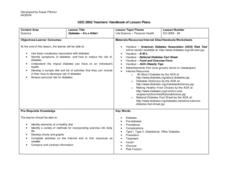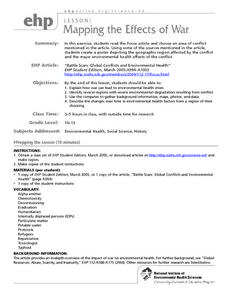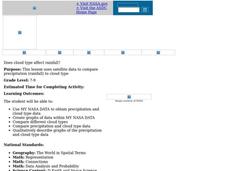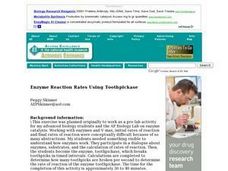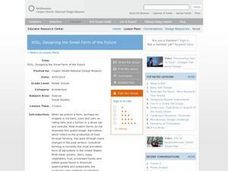Curated OER
You Won't Believe Your Eyes!
Students gain a basic understanding of the sense of sight. They watch a video on sight, then engage in some vocabulary games, and perform some simple experiments which focus on the basics of sight.
Curated OER
How Many Words Can You Say that Rhyme With Rice?
First graders practice their language art capabilities by rhyming words. In this vocabulary lesson, 1st graders examine words that rhyme with rice and create rhyming sentences using the same sound. Students complete a quick...
Curated OER
The Genetic Basis of Neurological Disorders
High schoolers describe some aspects of known genetic defects on the human neurological condition. They participate in a variety of exercises including drawings, games, and analogies.
Curated OER
Winnie the Pooh and the Honey Tree
Students dictate a story to the teacher. They practice key vocabulary. They be exposed to the language experience approach to writing. They watch a video as a listening exercise.
Alabama Learning Exchange
Writing Equations for Parallel Lines
Acquaint your class with the concept of parallel lines. Learners watch a PowerPoint presentation about how to write equations of parallel lines. Their understanding of linear equations and slope is taken a step further by the...
Curated OER
Diabetes - It's a Killer!
Students survey, graph and chart their prior knowledge about diabetes. They read a handout and complete a K-W-L chart. They develop a rubric to assess their diet and exercise and develop a shopping list, menu and exercise plan to share.
EngageNY
Real-World Positive and Negative Numbers and Zero
Class members investigate how positive and negative numbers are useful in the real world. Individuals first read a short passage and identify terms indicating positive and negative numbers. They consider situations involving positive...
Curated OER
Texture - Bumpy, Wrinkled, Smooth?
Students study textures and identify textures using satellite images. In this texture lesson, students study various objects and define their textures. Students feel crayon rubbings and sort them into groups. Students use a book with...
Curated OER
Wildlife Study Comparison
Pupils compare/contrast two studies that examine the effects of environmental contaminants on animals. They read an article, identify the components of a research study, summarize the article, and complete a matrix.
Curated OER
Mapping the Effects of War
Students examine how war can lead to environmental health crises. They read an article, conduct research on a region from the article, and create a poster to depict the geographic region and the environmental health effects of the conflict.
Curated OER
Water Microbes and Human Health
Students research the possible sources and human health effects of microbes found in recreational and drinking water. They explore the range of negative outcomes of contact with contaminated recreational and drinking water by creating...
Curated OER
Introduction, Advance Organizer, and the Problem
Students describe the three-phrase process for designing and developing energy-efficient buildings. They develop solutions and identify ways to make homes more comfortable and productive in regards to energy.
Curated OER
Does Cloud Type Affect Rainfall?
Student uses MY NASA DATA to obtain precipitation and cloud type data. They create graphs of data within MY NASA DATA. They compare different cloud types as well as precipitation types. They describe graphs of the precipitation and cloud...
Curated OER
Electrical Appliances
Students explore electricity in daily life by examining everyday appliances. In this electrical current lesson, students identify the differences between watts, volts and amps and how they relate to the devices we depend upon. Students...
Curated OER
Enzyme Reaction Rates Using Toothpicks
Students pretend to be enzyme that breaks toothpicks in timed intervals. They complete calculations to determine how many toothpicks are broken per second to determine the rate of reaction of the enzyme.
Curated OER
Conservation in Costa Rica
Students brainstorm what they do that requires land use and use a worksheet to calculate their footprint (the total area of land and water required to produce all the resources they consume). They then compare their footprints to each...
Curated OER
Thumbs Up, Thumbs Down: Grasping the Idea of Evolution
Students compare their performance of a series of tasks using their thumb and fingers to their performance of the same tasks without the use of their thumb. They discuss the role of fine and gross motor skills and speculate on the role...
Curated OER
Soil, Designing the Small Farm of the Future
Students examine the history of farming. In this environmental farming lesson, students explore the web and complete a variety of activities in order to understand the necessity of local, sustainable, and small farms for the future....
Curated OER
Senses of Taste and Smell
Students perform experiments to learn about their sense of taste and smell. In this taste and smell lesson, students watch as a blindfolded student tries to identify sounds and the direction they originate from. Students...
Curated OER
Biotechnology, GMOs and Food
Twelfth graders explore controversy around genetically modified foods, identify source of controversy, and role play town hall meeting on genetically modified foods, to examine viewpoints and arguments for and against genetic modification.
Curated OER
Build a Polyp
Students research coral polyps. In this coral polyps lesson, students discover the anatomy of a coral polyp and how they feed. Students create an edible coral polyp model.
Curated OER
What is an Ahupua'a?
Learners research ahupua'a ecosystems. In this ahupua'a lesson, students explore how land is subdivided in Hawaii and the effect on the ecosystem. Resources are provided.
Curated OER
Heat Up the Floating Plates
Eighth graders research the connection between the convection currents within the mantle of the earth and the moving of Earth's plates. A connection to lessons at previous grade levels on the rock cycle and important background...
Curated OER
Children's Literature Across the Curriculum Ideas-Ira Sleeps Over
Students read Ira Sleeps Over by Bernard Waber. They complete a variety of cross-curricular activities surrounding the ideas presented in the story. Included are reading, art, math, science, writing, social studies, and library...





